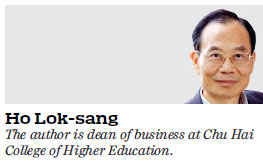Rationalization of harbor tunnels laudable but can be fine-tuned
Updated: 2018-10-16 07:35
(HK Edition)
|
|||||||||
Chief Executive Carrie Lam Cheng Yuet-ngor's Policy Address proposed raising tolls for the Cross-Harbour Tunnel and Eastern Harbour Crossing to HK$40 from HK$20 and HK$25 respectively for private vehicles and to reduce the toll for the Western Harbour Crossing to HK$50 from HK$70. Ownership of the first two crossings has already reverted to the Hong Kong government, in 1999 and 2016, respectively. The toll hikes on these crossings will bring a significant increase in revenue to the government. On the other hand, in order to reduce the toll on the western tunnel, as it is known locally, the government has proposed subsidizing its operations in exchange for a promise to contain future fare hikes to no more than $5 a year in the next five years until the build-operate-transfer lease expires in 2023.
This proposal very much resembles a proposal I made many years ago when I was still with Lingnan University. At the time I proposed to raise the Cross-Harbour Tunnel toll to $25 and reduce the western tunnel toll to $40 from $50. I argued that the apparent "subsidization" is not boosting the profit of a private company, but can be considered as the cost that the government pays for buying a service from a private company, so that the tunnel will not be underutilized and so that users of the Cross-Harbour Tunnel can save time. Moreover, the "subsidy" can also be interpreted as a subsidy to car users. It is obviously rational to divert traffic from the Cross-Harbour Tunnel, which is very congested, to the western tunnel, whose usage is still below its design capacity.
The proposal unfortunately attracted considerable criticism from the public. The criticism appears to be mainly based on the concern that the hike on the Cross-Harbour Tunnel is very high and to a lesser degree reflects a worry that the proposal translates to a subsidy to an already profitable private company.

I checked the increase in the consumer price index from 1999, when the HK$20 toll was first imposed, till now. The CPI has risen about 33 percent since that time. So doubling the toll from HK$20 to HK$40 does appear very high. Increasing the toll to HK$30 should lessen the objection considerably. With the western crossing toll reduced to HK$50, the decline from 70:20 to 50:30 would still go a long way in encouraging drivers currently using the Cross-Harbour Tunnel to switch to the western crossing.
Lam in a radio interview said that there would be no room for revision of the plan. We can understand that the terms agreed to with the Western Harbour Tunnel Company were reached after much negotiation, and may not be open for further negotiation. After all, the lease will have run its course by 2023. But how much the government charges on the Cross-Harbour Tunnel is entirely the purview of the SAR government. There is nothing to prevent the government to reduce the proposed new toll to, say, HK$30. The only implication is that the government will take in less revenue. By the same token, the toll for the Eastern Harbour Crossing is entirely the prerogative of the SAR government. There is really no necessity to raise the toll to HK$40. Reducing the proposed tolls on the Cross-Harbour Tunnel and the Eastern Harbour Crossing to HK$30 and HK$35 will make the scheme much more palatable to the public. The government really has no reason to insist on the proposed tolls.
The revised tolls are actually a more cautious and less risky move than the original proposal. As quite a few commentators have observed, even though the Cross-Harbour Tunnel is quite congested during the peak hours, at other times congestion is not that bad. On the other hand, the traffic from Sheung Wan through Central to Wan Chai is often very heavy. Although the Central-Wan Chai Bypass is expected to be completed by the end of this year, how much new traffic will be generated after it has been completed and after the tolls configurations have changed is unknown. The fact is, just as we do not want the western crossing to be underutilized, so we also do not want the Cross-Harbour Tunnel to be underutilized. We want our tunnels to be utilized optimally. Raising the tolls excessively may unnecessarily deter traffic, and that does not do anyone any good.
With the reduced new tolls on the Cross-Harbour Tunnel and on the Eastern Harbour Crossing, the government may make the case that since car users will spend less time on the roads, the time savings may actually more than offset the extra cost from the toll increase. But if the tolls are much higher, then the public will certainly see the increase as a rise in net burden. I would argue that a change from "take it or leave it" to a more responsive and flexible stance will earn the government support and encourage trust and communication. I would urge the government to be more enlightened in this livelihood matter.
(HK Edition 10/16/2018 page7)